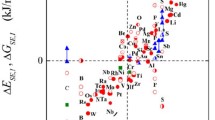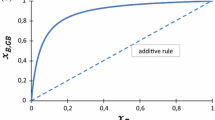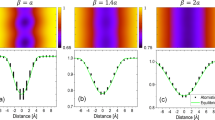Abstract
An analytical model of segregation at grain boundaries, which takes into account all five macroscopic parameters of grain boundary character, has been developed. The model is based on a combination of previous bond energy treatments of grain boundary energy and of segregation to free surfaces. It is tested by comparing its predictions against previous computations of segregation to symmetrical twist grain boundaries in simple fcc alloys obtained by Monte Carlo simulations in conjunction with embedded atom method potentials. The comparison shows good agreement with the previous computer simulations. Examples of model predictions in the case of asymmetric grain boundaries are also provided.
Similar content being viewed by others
References
J. W. GIBBS, “Collected Works” (Yale University Press, New Haven, CT, 1948), Vol. 1.
D. MCLEAN, “Grain Boundaries in Metals” (Clarendon Press, Oxford, 1957).
P. WYNBLATT and R. C. KU, in “Interfacial Segregation”, edited by W. C. Johnson and J. M. Blakely (American Society for Metals, Metals Park, OH, 1979) p. 115.
D. A. STEIGERWALD, S. J. MILLER and P. WYNBLATT, Surf. Sci. 155 (1985) 79.
P. WYNBLATT and M. TAKASHIMA, Interf. Sci. 9 (2001) 265.
Y. W. LEE and H. I. AARONSON, Acta Metall. 28 (1980) 539.
Idem., Surf. Sci.95 (1980) 227.
D. WOLF, Acta Metall. 37 (1989) 1983.
Idem., Acta Metall.37 (1989) 2823.
Idem., Acta Metall. Mater.38 (1990) 791.
M. A. VAN HOVE and G. A. SOMORJAI, Surf. Sci. 92 (1980) 489.
P. WYNBLATT and M. TAKASHIMA, in “Proceedings of HTC-2000, edited by N. Eustathopoulos, K. Nogi and N. Sobczac, Trans. JWRI (2001), Vol 30, p. 11.
J. FRIEDEL, Avan. Phys. 3 (1954) 446.
J. D. ESHELBY, in “Progress in Solid Mechanics”, edited by Sneddon and Hill, (North-Holland, Amsterdam, 1961) Vol. 2, p. 275.
D. UDLER and D. N. SEIDMAN, Phys. Stat. Sol. B 172 (1992) 267.
Idem., Acta Metal. Mater.42 (1994) 1959.
J. D. RITTNER and D. N. SEIDMAN, Phyical Rev. B 54 (1996) 6999.
S. M. FOILES, M. I. BASKES and M. S. DAW, Phyical Rev. 33 (1985) 7983.
Author information
Authors and Affiliations
Corresponding author
Rights and permissions
About this article
Cite this article
Wynblatt, P., Shi, Z. Relation between grain boundary segregation and grain boundary character in FCC alloys. J Mater Sci 40, 2765–2773 (2005). https://doi.org/10.1007/s10853-005-2406-9
Issue Date:
DOI: https://doi.org/10.1007/s10853-005-2406-9




